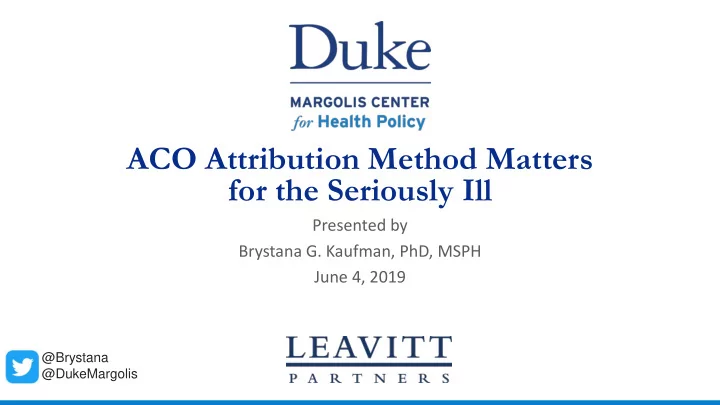

ACO Attribution Method Matters for the Seriously Ill Presented by Brystana G. Kaufman, PhD, MSPH June 4, 2019 @Brystana @DukeMargolis
Acknowledgements and Disclosures William K. Bleser 1 , PhD, MSPH Brystana G. Kaufman 1 , PhD, MSPH Robert Saunders 1 , PhD David Anderson 1 , MSPPM; Lia Winfield 2 , PhD Courtney Van Houtven 3 , PhD Mark Japinga 1 , MPAff David B. Muhlestein 4 , PhD, JD Nathan Smith 2 , PhD Mark B. McClellan 1 , MD, PhD Hannah L. Crook 1 1 Robert J. Margolis, MD, Center for Health Policy, Duke University, Washington, DC 2 Leavitt Partners, Salt Lake City, UT 3 Department of Population Health Sciences, Duke University School of Medicine, Durham, NC 4 Leavitt Partners, Washington, DC; Funded by the Gordon and Betty Moore Foundation 5/31/2019
Serious Illness Care in ACOs 75% of Any Inpatient claim* readmissions AND 10% Any Skilled Nursing, 47% of Home Health or DME of Claim* AND Medicare Costs ACO a serious illness OR 3+ other comorbidities: >$50K PBPY *Calendar year prior to ACO PY; Medicare fee-for-service Beneficiary Summary File, Chronic Conditions Warehouse, Cost &Use 3
Medicare Shared Savings Program Retrospective Attribution Prospective Attribution • Most MSSP Contracts • Physician Group Practice • After Performance Year Demonstration • Before Performance Year 5/31/2019 4
Prospective Retrospective Cohort Cohort Decedents Prospective Retrospective ONLY ONLY Patients in Both Cohorts ACO Attribution Conceptual Model
Prospective ACO cohorts include more decedents Retrospective Cohort Prospective Cohort • N=1,306,722* • N=1,336,562* • 13% died • 16% died • $37,400 pbpy (actual) • $47,300 pbpy (actual) • $33,000 pbpy (truncated) • $35,600 pbpy (truncated) Retrospective Only Prospective Only • N=264,067 • N=293,907 • 14% died • 28% died • $47,200 pbpy (actual) • $91,400 pbpy (actual) • $40,500 pbpy (truncated) • $51,500 pbpy (truncated) *Overlapping; 100% National Medicare FFS Claims Data Notes: 2015-2016 PY; PBPY=Per Beneficiary Per Year Medicare Expenditures; 5/31/2019 6 Costs are inflated, standardized, annualized, and truncated
Retrospective Attribution Rates: Lowest for Q1 Decedents 1.00 0.77 Predicted Probability 0.80 0.70 0.66 0.60 0.45 0.40 Con Condit itional on on Pros ospectiv ive 0.20 Assig ssignment (PY (P Y 2015 2015-2016) 2016) 0.00 <90 Days 90-179 Days 180-269 Days 270+ Days (N=69,485) (N=50,976) (N=42,941) (1,173,160) 7 Beneficiary Survival
MSSP Stop Loss Rule: D ifferentially impacts decedents’ annualized costs Among Among Among Among FFS Seriously Ill Decedents Truncated Top 1% of 5% were 25% were 80% were FFS truncated truncated decedents truncated 8
Per Beneficiary Per Year Costs: Higher in Prospective than Retrospective Cohorts $29,520 $28,266 $27,061 $24,973 Retrospective Cohort Prospective Cohort Retrospective Cohort Prospective Cohort ACOs with Shared Savings (N=253) ACOs without Shared Savings (N=571) 9 Generalized Linear Model with exchangeable correlation structure; ACO and Year Fixed Effects;
@Brystana @DukeMargolis ACOs and Serious Illness Care 1. Prospective 3. Prospective 2. Truncation cohorts include cohorts are more differentially impacts decedents more decedents. expensive Increase Risk adjustment and Consider alternatives accountability for unintended to annualizing costs high risk patients consequences 10
References • Kelley, A. S. (2013). Epidemiology of care for patients with serious illness. J Palliat Med, 16 (7), 730-733. Retrieved from http://dx.doi.org/10.1089/jpm.2013.9498. doi:10.1089/jpm.2013.9498 • Kelley, A. S. (2014). Defining "serious illness". J Palliat Med, 17 (9), 985. Retrieved from http://dx.doi.org/10.1089/jpm.2014.0164. doi:10.1089/jpm.2014.0164 • Kelley, A. S., & Bollens-Lund, E. (2018). Identifying the Population with Serious Illness: The "Denominator" Challenge. J Palliat Med, 21 (S2), S7-s16. Retrieved from http://dx.doi.org/10.1089/jpm.2017.0548. doi:10.1089/jpm.2017.0548 • Kelley, A. S., Covinsky, K. E., Gorges, R. J., McKendrick, K., Bollens-Lund, E., Morrison, R. S., & Ritchie, C. S. (2017). Identifying Older Adults with Serious Illness: A Critical Step toward Improving the Value of Health Care. Health Serv Res, 52 (1), 113-131. Retrieved from http://dx.doi.org/10.1111/1475-6773.12479. doi:10.1111/1475-6773.12479 • Kelley, A. S., Morrison, R. S., Wenger, N. S., Ettner, S. L., & Sarkisian, C. A. (2010). Determinants of treatment intensity for patients with serious illness: a new conceptual framework. J Palliat Med, 13 (7), 807-813. Retrieved from http://dx.doi.org/10.1089/jpm.2010.0007. doi:10.1089/jpm.2010.0007 5/31/2019 11
Serious Illness Criteria 1) Any Inpatient claim* AND 2) Any Skilled Nursing, Home Health or DME Claim* AND 3) A OR B: A. 3+ of the Following: B. Any 1 of the following: Myocardial Infarction Advanced liver disease or cirrhosis Atrial Fibrillation Cancer: Lung, colorectal or endometrial Ischemic Heart Disease Chronic obstructive pulmonary disease Depression Congestive heart failure Rheumatoid/ Osteoarthritis Dementia including Alzheimer’s Osteoporosis Diabetes with ischemic heart disease or Transient Ischemic Attack peripheral vascular disease Cancer: Breast or Prostate Hip fracture Asthma Chronic Kidney Disease Renal failure as indicated by Dialysis Diabetes *Within a calendar year using Medicare fee for service claims (5% sample and MBSF); lagged for attribution analysis; 12
Medicare Expenditures Defined using annual cost and use beneficiary summary files annualized to adjust for survival<1yr, as done in calculation of MSSP per capita spending adjusted for inflation using Consumer Price Index Standardized across counties using CMS geographic payment adjustment factors. Annualized costs were truncated at the 99 th percentile in the full fee-for-service Medicare population by eligibility code group, as done in calculation of MSSP per capita spending Attribution Models are adjusted for beneficiary age, gender, race, hospice use, E&M visit, as well as county HCC, Medicare advantage and Medicaid rates; year fixed effects. ACO PBPY models adjust for ACO and year fixed effects and apply exchangeable correlation structure. 13
$180 Medicare Expenditures, $1000 $160 Impact of the Stop Loss $140 Rule on PBPY Costs $120 $100 $80 $60 $40 $20 $- Retrospective Prospective Retrospective Prospective Retrospective Prospective All Seriously Ill Hospice Users Decedents (N=1,600,629) (N=164,264) (N=255,852) PBPY, truncated PBPY, actual 14
Recommend
More recommend